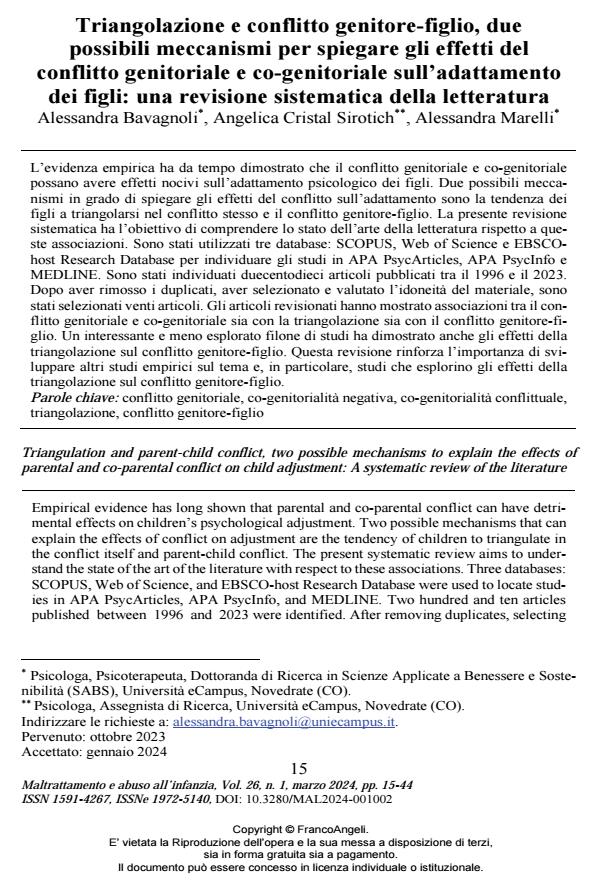Triangolazione e conflitto genitore-figlio, due possibili meccanismi per spiegare gli effetti del conflitto genitoriale e co-genitoriale sull’adattamento dei figli: una revisione sistematica della letteratura
Titolo Rivista MALTRATTAMENTO E ABUSO ALL’INFANZIA
Autori/Curatori Alessandra Bavagnoli, Angelica Cristal Sirotich, Alessandra Marelli
Anno di pubblicazione 2024 Fascicolo 2024/1
Lingua Italiano Numero pagine 30 P. 15-44 Dimensione file 281 KB
DOI 10.3280/MAL2024-001002
Il DOI è il codice a barre della proprietà intellettuale: per saperne di più
clicca qui
Qui sotto puoi vedere in anteprima la prima pagina di questo articolo.
Se questo articolo ti interessa, lo puoi acquistare (e scaricare in formato pdf) seguendo le facili indicazioni per acquistare il download credit. Acquista Download Credits per scaricare questo Articolo in formato PDF

FrancoAngeli è membro della Publishers International Linking Association, Inc (PILA)associazione indipendente e non profit per facilitare (attraverso i servizi tecnologici implementati da CrossRef.org) l’accesso degli studiosi ai contenuti digitali nelle pubblicazioni professionali e scientifiche
L’evidenza empirica ha da tempo dimostrato che il conflitto genitoriale e co-genitoriale possano avere effetti nocivi sull’adattamento psicologico dei figli. Due possibili mecca-nismi in grado di spiegare gli effetti del conflitto sull’adattamento s-no la tendenza dei figli a triangolarsi nel conflitto stesso e il conflitto genitore-figlio. La presente revisione sistematica ha l’obiettivo di comprendere lo stato dell’arte della letteratura rispetto a queste associazioni. Sono stati utilizzati tre database: SCOPUS, Web of Science e EBSCO-host Research Database per individuare gli studi in APA PsycArticles, APA PsycInfo e MEDLINE. Sono stati individuati duecentodieci articoli pubblicati tra il 1996 e il 2023. Dopo aver rimosso i duplicati, aver selezionato e valutato l’idoneità del materiale, sono stati selezionati venti articoli. Gli articoli revisionati hanno mostrato associazioni tra il conflitto genitoriale e co-genitoriale sia con la trian-golazione sia con il conflitto genitore-figlio. Un interessante e meno esplorato filone di studi ha dimostrato anche gli effetti della triangolazione sul conflitto genitore-figlio. Questa revisione rinforza l’importanza di sviluppare altri studi empirici sul tema e, in particolare, studi che esplorino gli effetti della triangolazione sul conflitto genitore-figlio.
Parole chiave:conflitto genitoriale, co-genitorialità negativa, co-genitorialità conflit-tuale, triangolazione, conflitto genitore-figlio
Alessandra Bavagnoli, Angelica Cristal Sirotich, Alessandra Marelli, Triangolazione e conflitto genitore-figlio, due possibili meccanismi per spiegare gli effetti del conflitto genitoriale e co-genitoriale sull’adattamento dei figli: una revisione sistematica della letteratura in "MALTRATTAMENTO E ABUSO ALL’INFANZIA" 1/2024, pp 15-44, DOI: 10.3280/MAL2024-001002